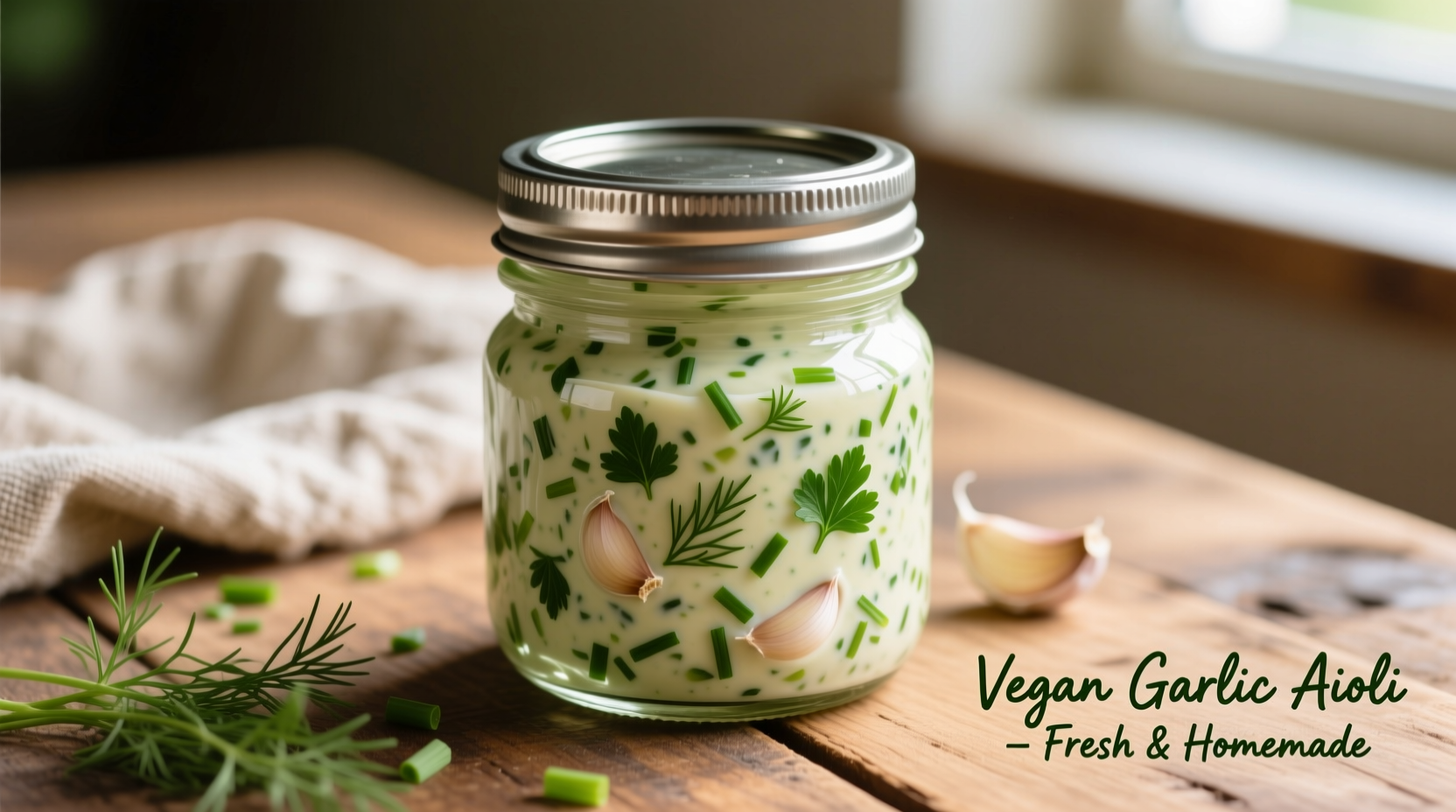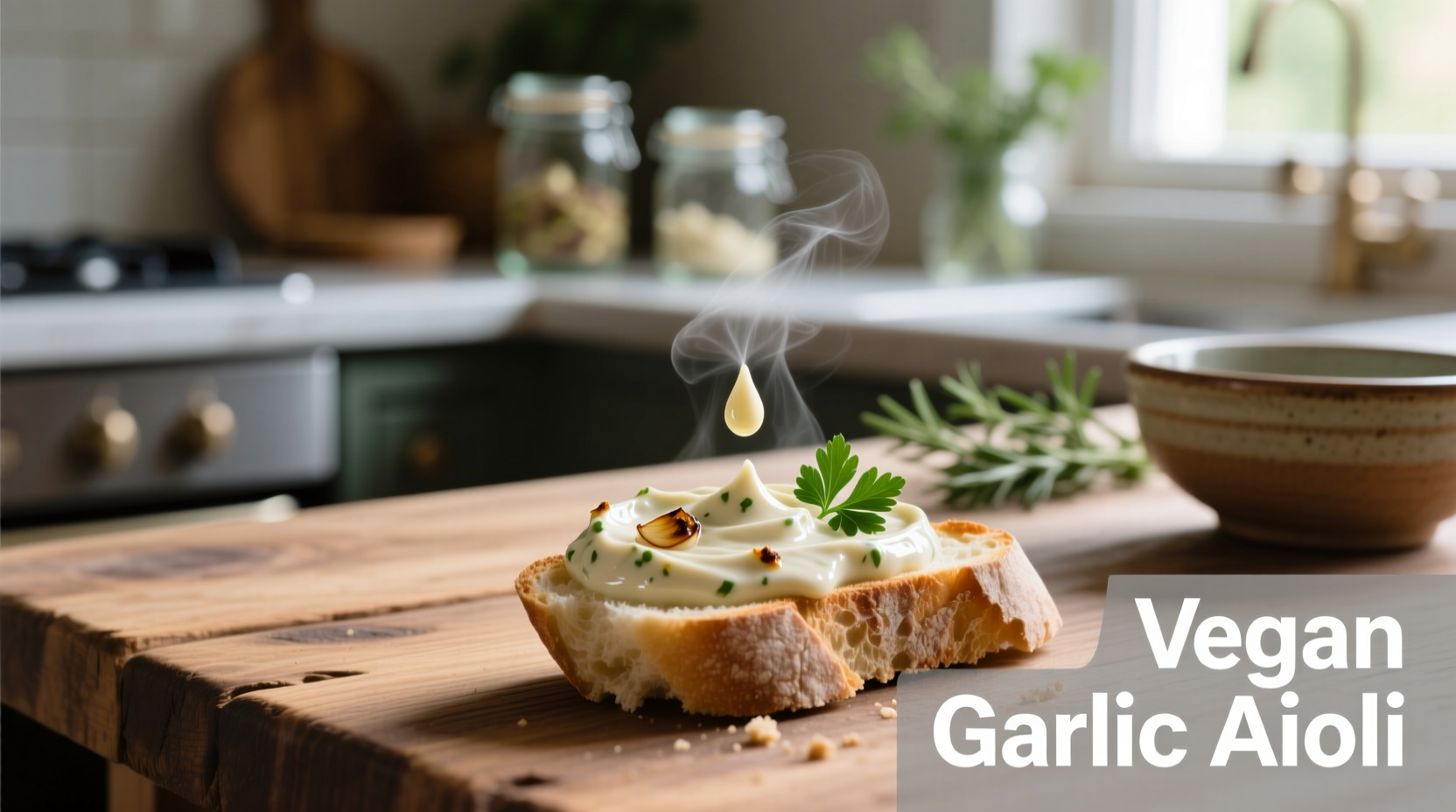The Science Behind Perfect Vegan Garlic Aioli
Creating stable emulsions without eggs challenges conventional cooking wisdom. Traditional aioli relies on egg yolks' lecithin to bind oil and water, but vegan versions use alternative emulsifiers. Food scientists at the Institute of Food Technologists confirm that aquafaba (chickpea brine) contains proteins and carbohydrates that form stable emulsions when properly whipped. This plant-based approach maintains the luxurious texture while eliminating cholesterol and allergens.
| Characteristic | Traditional Aioli | Vegan Garlic Aioli |
|---|---|---|
| Primary Emulsifier | Egg yolk lecithin | Aquafaba or cashew cream |
| Cholesterol Content | 185mg per serving | 0mg |
| Shelf Stability | 3-4 days refrigerated | 5-7 days refrigerated |
| Allergen Profile | Egg allergen present | Free from major allergens |
Essential Ingredients for Authentic Flavor
Garlic quality makes or breaks your vegan aioli. The University of California's Agriculture Department recommends using fresh, firm garlic bulbs with tight skins for optimal flavor development. Unlike traditional recipes that mellow garlic through raw preparation, vegan versions benefit from roasted garlic which enhances sweetness without overpowering the delicate emulsion. For the oil component, extra virgin olive oil provides authentic Mediterranean flavor, but avocado oil offers better stability for beginners.

Step-by-Step Preparation Guide
Follow this professional technique for foolproof results:
- Prepare your garlic base - Roast 4-5 cloves at 375°F for 15 minutes until soft
- Create your emulsion foundation - Whip 1/4 cup aquafaba until frothy (2-3 minutes)
- Slow incorporation - Add oil drop by drop initially, then in thin stream once emulsion forms
- Acid balance - Incorporate lemon juice gradually to taste (start with 1 tbsp)
- Resting period - Chill for minimum 2 hours before serving to allow flavors to meld
Contextual Application Guide
Vegan garlic aioli excels in specific culinary applications while having limitations in others. According to culinary research from the Culinary Institute of America, it performs exceptionally well as:
- Sandwich spread (especially with roasted vegetables)
- Dipping sauce for artichokes and asparagus
- Base for vegan remoulade
- Marinade component for grilled tofu
However, it's less suitable for high-heat applications above 160°F where the emulsion may break. The USDA Food Safety and Inspection Service recommends consuming homemade vegan aioli within 7 days when properly refrigerated below 40°F.
Flavor Evolution Timeline
Understanding how vegan aioli's flavor profile develops over time ensures optimal serving:
- Immediately after preparation: Sharp garlic notes dominate with pronounced acidity
- After 2 hours chilling: Flavors begin integrating, garlic mellows slightly
- 12-24 hours: Peak flavor harmony as garlic compounds transform
- After 3 days: Gradual flavor degradation, increased separation risk
Customization Options for Every Palate
Professional chefs modify their vegan garlic aioli based on regional preferences and dietary needs:
- Mediterranean style: Add roasted red peppers and smoked paprika
- Asian fusion: Incorporate wasabi paste and rice vinegar
- Herb-infused: Blend in fresh dill, chives, and parsley
- Spicy variation: Mix in chipotle peppers in adobo sauce
For those with nut allergies, cashew-based versions can be substituted with sunflower seed cream or silken tofu while maintaining creaminess. The American Heart Association recognizes these plant-based alternatives as heart-healthier options compared to traditional egg-based versions.
Frequently Asked Questions
Can I make vegan garlic aioli without aquafaba?
Yes, cashew cream provides excellent emulsion properties. Soak 1 cup raw cashews in hot water for 15 minutes, then blend with 1/4 cup water until completely smooth before incorporating oil. Blanched almonds or sunflower seeds work as nut-free alternatives.
Why does my vegan aioli separate and how can I fix it?
Separation occurs when oil is added too quickly before emulsion forms. To fix, start with 1 tablespoon of your separated mixture in a clean bowl, then slowly whisk in the remaining mixture drop by drop. Adding a teaspoon of mustard can help stabilize the emulsion due to its additional emulsifying compounds.
How long does homemade vegan garlic aioli last in the refrigerator?
Properly stored in an airtight container below 40°F, vegan garlic aioli maintains quality for 5-7 days. The absence of eggs extends shelf life compared to traditional versions. Always check for sour smell or visible mold before consumption. For best flavor, consume within 3 days.
What's the best oil to use for vegan garlic aioli?
Extra virgin olive oil provides authentic Mediterranean flavor but has a lower smoke point. Avocado oil offers neutral flavor with excellent emulsifying properties and higher stability. For traditional flavor with better stability, use a 50/50 blend of extra virgin olive oil and a neutral oil like grapeseed.











 浙公网安备
33010002000092号
浙公网安备
33010002000092号 浙B2-20120091-4
浙B2-20120091-4